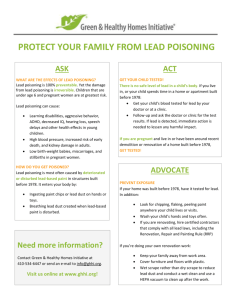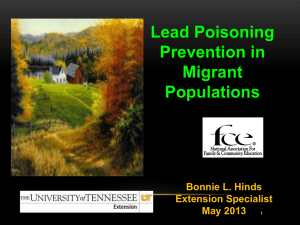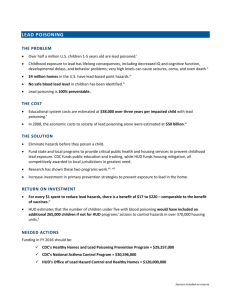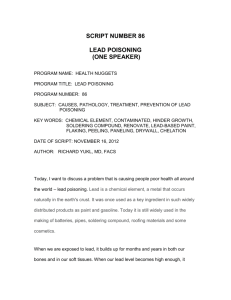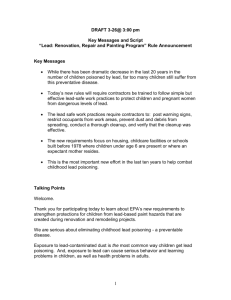Subj:
advertisement
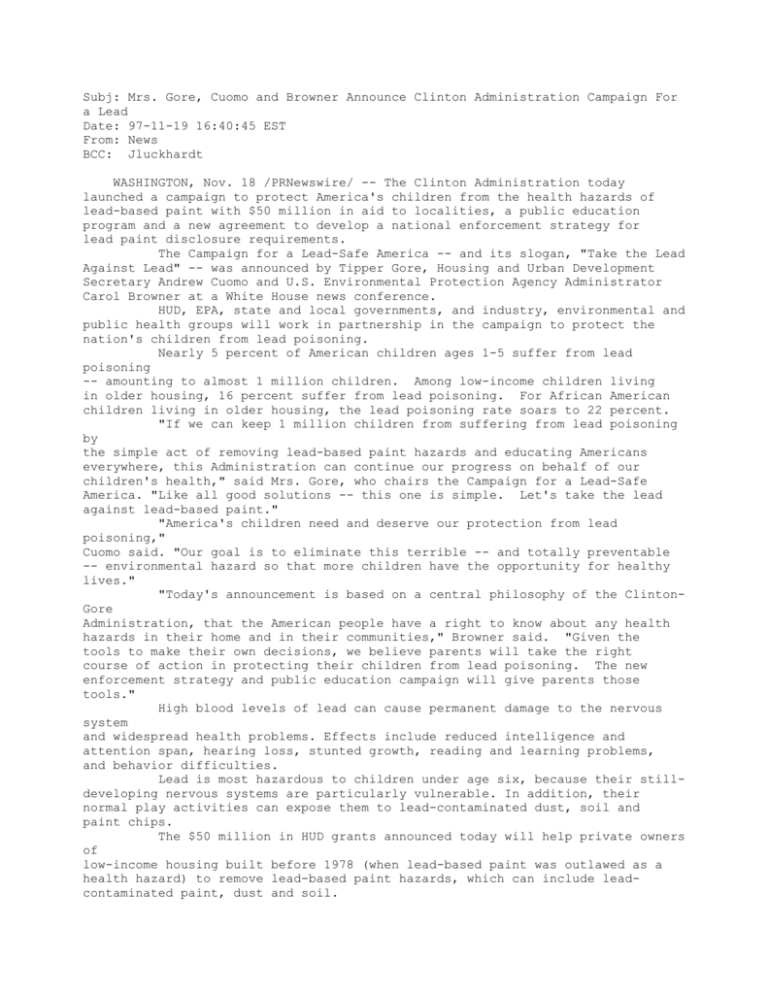
Subj: Mrs. Gore, Cuomo and Browner Announce Clinton Administration Campaign For a Lead Date: 97-11-19 16:40:45 EST From: News BCC: Jluckhardt WASHINGTON, Nov. 18 /PRNewswire/ -- The Clinton Administration today launched a campaign to protect America's children from the health hazards of lead-based paint with $50 million in aid to localities, a public education program and a new agreement to develop a national enforcement strategy for lead paint disclosure requirements. The Campaign for a Lead-Safe America -- and its slogan, "Take the Lead Against Lead" -- was announced by Tipper Gore, Housing and Urban Development Secretary Andrew Cuomo and U.S. Environmental Protection Agency Administrator Carol Browner at a White House news conference. HUD, EPA, state and local governments, and industry, environmental and public health groups will work in partnership in the campaign to protect the nation's children from lead poisoning. Nearly 5 percent of American children ages 1-5 suffer from lead poisoning -- amounting to almost 1 million children. Among low-income children living in older housing, 16 percent suffer from lead poisoning. For African American children living in older housing, the lead poisoning rate soars to 22 percent. "If we can keep 1 million children from suffering from lead poisoning by the simple act of removing lead-based paint hazards and educating Americans everywhere, this Administration can continue our progress on behalf of our children's health," said Mrs. Gore, who chairs the Campaign for a Lead-Safe America. "Like all good solutions -- this one is simple. Let's take the lead against lead-based paint." "America's children need and deserve our protection from lead poisoning," Cuomo said. "Our goal is to eliminate this terrible -- and totally preventable -- environmental hazard so that more children have the opportunity for healthy lives." "Today's announcement is based on a central philosophy of the ClintonGore Administration, that the American people have a right to know about any health hazards in their home and in their communities," Browner said. "Given the tools to make their own decisions, we believe parents will take the right course of action in protecting their children from lead poisoning. The new enforcement strategy and public education campaign will give parents those tools." High blood levels of lead can cause permanent damage to the nervous system and widespread health problems. Effects include reduced intelligence and attention span, hearing loss, stunted growth, reading and learning problems, and behavior difficulties. Lead is most hazardous to children under age six, because their stilldeveloping nervous systems are particularly vulnerable. In addition, their normal play activities can expose them to lead-contaminated dust, soil and paint chips. The $50 million in HUD grants announced today will help private owners of low-income housing built before 1978 (when lead-based paint was outlawed as a health hazard) to remove lead-based paint hazards, which can include leadcontaminated paint, dust and soil. In addition, the funds can be used for blood testing of young children, inspection and testing of homes for lead hazards, temporary relocation of families during lead control work, community education and outreach, and collection and analysis of data on lead hazards. The $50 million in grants will go to these 25 state and local governments: Akron (OH) -- $2.5 million; Alameda County (CA) -- $1.4 million; Baltimore -$2 million; Boston -- $642,000; Butte-Silver Bow (MT) -- $558,000; Cuyahoga County (OH) -- $1.5 million; District of Columbia -- $2.2 million; Grand Gateways Economic Development Association (OK) -- $1.4 million; Harris County (TX) -- $2.2 million; Houston -- $2 million; Lawrence (MA) -- $2.9 million; Long Beach (CA) -- $2 million; Los Angeles -- $2.9 million; Lynchburg (VA) -$2.3 million; Manchester (CT) -- $2 million; Monroe County (NY) -- $1.7 million; New Hampshire -- $2.9 million; Phoenix -- $2 million; Portland (ME) - $1.4 million; Portland (OR) -- $2.9 million; East Providence (RI) -- $1.6 million; Richmond (CA) -- $2.3 million; Richmond (VA) -- $2 million; St. Louis -- $2.9 million; and Springfield (MA) -- $1.8 million. The new public education program unveiled today will feature: public service advertising in publications throughout the nation; videos featuring Sesame Street characters; educational materials distributed by major hardware retailers (Lowe's, Home Depot, Sears and ACE) in over 6,000 stores; distribution of an illustrated book called Maintaining a Lead-Safe Home to 3,500 libraries; distribution of a new interactive video training course for maintenance workers to teach them to do their work safely; and campaigns involving the National Association of Realtors, the Consumer Federation of America and other groups. In addition, HUD and EPA are jointly funding a toll-free phone line (1-800-424-LEAD) to give callers information about lead hazards and about disclosure requirements for people selling and renting homes. Information is also available on HUD's internet site at www.hud.gov/lea/leahome.html and on EPA's site at www.epa.gov/opptinter By alerting parents to the dangers of lead-based paint, the education campaign is designed to help parents avoid exposing their children and themselves to lead. The tag line on the public service material is: "Learn before you rent, buy or renovate." HUD and EPA announced they have entered into a memorandum of understanding that will serve as the basis for a nationwide enforcement strategy to be unveiled in the future that will ensure compliance with a federal "right to know" requirement about lead-based paint. This "right to know" rule requires home sellers and landlords to disclose known lead hazards to prospective homebuyers and tenants, so people can protect their families from exposure to lead. An estimated 64 million homes and apartment units in the United States built before 1978 are covered by the lead-based paint disclosure rule. About 20 million of these dwellings have lead-based paint in a hazardous condition. About 3.8 million dwellings with lead-based paint are currently occupied by children under age six. An estimated 9 million new tenants and 3 million homebuyers should receive information under the "right to know" disclosure rule each year. The rule also requires that sellers and landlords of most housing built before 1978 give buyers and tenants a pamphlet about lead-based paint hazards, and requires that prospective homebuyers be given the opportunity to inspect a home for lead-based paint before signing a sales contract. Cities with high concentrations of homes with potential lead hazards will be targeted for special attention under a nationwide enforcement and compliance strategy that will be developed by EPA and HUD, including: Baltimore, Boston, Buffalo, Chicago, Cleveland, Columbus (OH), Detroit, Houston, Indianapolis, Jersey City, Los Angeles, New York City, New Orleans, Oakland (CA), Philadelphia, Pittsburgh, Providence, Minneapolis/St. Paul, Richmond (VA), Rochester (NY), St. Louis, San Francisco, Savannah (GA), Washington, and Youngstown (OH). HUD will work with health departments in each of these 25 cities to seek their assistance in providing information about lead poisoning cases, to further the compliance strategy. At their announcement of the Campaign for a Lead-Safe America, Mrs. Gore, Cuomo and Browner were joined by Baltimore Mayor Kurt Schmoke and by Margaret Sauser, who is President of National United Parents Against Lead, founder of United Parents Against Lead of Michigan and the mother of two young sons who have suffered serious health problems from lead poisoning. "Lead paint poisoning is a major health problem in older American cities," Schmoke said. "Combatting this problem through innovative public-private partnerships must be a national priority." Jon and Margaret Sauser's sons -- Jonathan, now age 9, and Cameron, age 6, -- suffered lead poisoning after the couple renovated a 67-year-old home they purchased in 1990 in Kalamazoo, MI. The Sausers didn't know that the old layers of paint they removed from the home and garage contained lead, and spread invisible lead dust through the home. They were also unaware that old lead pipes in their home contaminated their water with lead. The lead poisoning caused Jonathan to experience behavior problems, learning difficulties, insomnia, stomach problems, and other ailments. Cameron, who was born into the lead-contaminated home, experienced slowed growth, difficulties with speech and motor skills, and other problems. After learning of the lead contamination of their home three years after they moved in, the Sausers moved and declared bankruptcy when they were told they would be unable to sell the contaminated home. "If only we had known in 1990 what we know now about lead, our sons would never have been poisoned," Mrs. Sauser said. "No parent and no child should have to go through this. By making more parents aware of the dangers of lead, this new federal initiative will benefit children around the nation. Our precious youth must no longer remain our lead detectors. We must find the lead before it finds our children." FOR MORE INFORMATION ON LOCAL GRANTS SEE HUD WEBSITE OR CALL HUD. Grant Recipients Recipient Project Location Award Amount The Neighborhood Phoenix, Arizona $2,000,000 Services Department The City of Phoenix has been awarded a lead-based paint hazard control grant to reduce lead paint hazards in 215 homes in five neighborhoods in Phoenix. A local match of $699,042 has been pledged for a total grant amount of $2,699,042. The program is a joint effort of the City of Phoenix Neighborhood Services Department, the Maricopa County Department of Health Services, the Arizona Department of Health Services, and neighborhood associations. This grant will enable the city to raise public awareness while concentrating on blood screening, education, social services, health care case management, environmental assessment, and remediation efforts. The City of Long Long Beach, $2,000,000 Beach Department of California Health and Human Services This grant will abate lead hazards in 305 family-occupied housing units in the City of Long Beach. In addition, it will create an environment and a demand for lead hazard control that will provide property owners with an incentive to share in the he cost of these activities. City of Los Angeles Los Angeles, $2,900,000 California The Los Angeles Housing Department will administer the grant program by funding removal of assembly components and plaster walls coated with lead-based paint, waste characterization and disposal and three sets of dust wipe tests. In addition they will distribute literature on lead poisoning prevention and brochures about the lead hazard control program. The grant will also cover blood lead tests for children under six residing in units scheduled for grant-funded lead hazard treatments. City of Richmond Richmond, California $2,300,000 This grant will implement the Project REAL (Richmond Effort to Abate Lead) as a comprehensive program to reduce the hazards of lead in privately owned housing units in severely economically distressed and minority communities. Project REAL will conduct lead hazard control activities in a minimum of 160 housing units in three targeted neighborhoods. City of Manchester Manchester, $2,000,000 Connecticut This grant will assist owners with correcting code violations. Lead testing of units, blood screening, abatement/management plans and relocation will be underwritten for program participants. Historic preservation will receive special attention and development. In addition, new measures will aim at higher performance and participation by construction contractors. District of Columbia Washington, D.C. $2,200,000 This project will target 1,375 housing units in Wards 1,2,4,5 and 6, which comprises 70% of the pre-1950 housing stock in D.C. These are also the Wards which consistently show the highest percentage of children with elevated blood levels. The grant will also provide for the development of programs to heighten the public's understanding of the hazards of leadbased paint. City of Portland Portland, Maine $1,400,000 There are approximately 31,293 housing units in the City, over half of which were constructed prior to 1950. Since 1992, Portland's Public Health Division has documented that 93% of all lead poisoning cases have occurred in these pre-1950 rental buildings. Portland expects to conduct lead hazard reduction in 120 units within the three-year grant period. The City of Portland will also continue its community awareness and educational efforts by participating in home buyer training programs, counseling of tenants, case management of families with lead poisoned children and other community awareness programs. City of Baltimore Baltimore, Maryland $2,000,000 The primary goal of this grant is to reduce lead-poisoning through the abatement of 200 housing units and to provide employment opportunities in distressed communities of the city. The program emphasis for this effort will focus on multi-family properties. This will allow the City to protect children in a shorter period of time. City of Lawrence Lawrence, $2,900,000 Massachusetts This grant will provide resources to a consortium of four agencies that have extensive experience in providing technical assistance and financial resources to low-income families in five high-risk cities in Massachusetts. The Massachusetts High-Risk Consortium consists of: City of Lawrence, City of Chelsea, Brockton (under Self Help Inc.), and Fall River/New Bedford (under UMASS/Dartmouth Lead Program). City of Springfield Springfield, $1,800,000 Massachusetts The City of Springfield has been working cooperatively with the neighboring cities of Chicopee, Holyoke, and Westfield, in a regional initiative to create and implement effective strategies for addressing the issue of lead-based paint hazards. Funds will be targeted to those neighborhoods in each community which contain both the oldest housing stock and the greatest concentration of low- and very-low income families with children. Hazardous waste disposal, inspections, outreach, education and relocation will also be part of this grant program. City of St. Louis St. Louis, Missouri $2,900,000 This grant program will be a collaborative effort of the Community Development Agency and the Department of Health and Hospitals. The efforts include a Primary Prevention Risk Reduction Project to identify children at risk of lead poisoning. The grant anticipates 600 children will be enrolled in this program. The City reports that the incidence of lead poisoning is six times the national rate. New Hampshire State of New $2,900,000 Housing Finance Hampshire Authority (NHHFA) NHHFA will administer its grant through multi-family comprehensive rehabilitation and complete lead abatement. NHHFA will collaborate with the New Hampshire Department of Health and Human Services, Office of Health Management, in the development of a strategy to educate property owners and tenants about the potential hazards of lead-based paint. The County of Monroe State of New York $1,700,000 The County of Monroe, which includes the City of Rochester, will use its grant to provide screening of children, medical management, environmental investigation, pursuit of abatement (including enforcement), and health education. City of Akron Akron, Ohio $2,500,000 The Akron Health Department, which will be acting as the lead agency for the Akron Lead-based Paint Hazard Control Program, will reduce the lead hazards in at least 100 homes of low-tomoderate income families with children under the age of six. In addition, the grant will allow for tenant relocation, and outreach and educational initiatives. Cuyahoga County State of Ohio $1,500,000 The Cuyahoga County Board of Health, in partnership with the Cuyahoga County Department of Development, plans to expand their current lead hazard control efforts in the first ring of communities of Cleveland, Ohio. Cuyahoga plans to conduct approximately 1,400 door-to-door visits in the target census tracts to educate residents about lead poisoning. City of Portland Portland, Oregon $2,900,000 The grant will enable the city to do lead hazard control work in 600 low-to moderate-income housing units. In addition, the city will provide community awareness, education and outreach to homeowners, homeowner occupants, landlords and the general public. City of East Providence, Rhode $1,600,000 Providence Island Rhode Island has some of the highest rates of childhood lead poisoning in the country and the State has dealt aggressively with the issue by taking steps in its prevention through the passing of legislation and the creation of community-based educational programs. The City of East Providence will use its grant for inspection and lead hazard control, a public education and awareness program, and a job training program. Harris County State of Texas $2,200,000 This grant will fund the screening of children in targeted areas (cities of Baytown, Pasadena, Galena Park, Jacinto City, and La Porte as well as the areas of Aldine, Cloverleaf, McNair, Barrett Station, and Channelview) through outreach to schools, health care providers, and mobile clinics of the Harris County Health Department. The County expects that 10,000 children will be screened as part of this program. City of Houston Houston, Texas $2,000,000 The City of Houston will use its grant to prepare for leadhazard reduction including: identifying and pre-qualifying housing units; identifying potential contractors and candidates for state-certified training; requesting contractor qualifications and negotiating contracts. Families will be relocated to lead-safe housing when it is determined that the lead hazard education will compromise their health and safety. City of Lynchburg Lynchburg, Virginia $2,300,000 This grant will be administered by a collaborative organization, the Lynchburg Lead Initiatives representing the City of Lynchburg, several non-profit organizations, and several local colleges. 200 houses will be abated in the inner-city areas of highest risk. The program will also provide support services to residents of the targeted areas which include education, case management, skills training, and economic development. City of Richmond Richmond, Virginia $2,000,000 The Richmond City Department of health in collaboration with the Richmond City Department of Community Development will manage this grant. The goal is to reduce lead poisoning in children through the identification and abatement of lead hazard in 300 housing units in targeted zones in the city. The target zones are the East District, North District, and South District of the city which have the oldest housing stock, lowest income levels, and highest number of children under the age of six. Superfund or Brownfield Sites Recipient Project Location Award Amount Alameda County State of California $1,400,000 This grant will remediate 120 residences at the Verdes Carter Park Superfund site. The funding will remediate residential lead hazards, thereby affording the community an opportunity to overcome the remaining impediment to fulfilling its search for environmental justice. City of Boston Boston, $ 642,000 Massachusetts The City of Boston will use its grants to remediate Brownfields sites that will become the site of 77 units of newly constructed, lead safe housing surrounded by lead safe yards. In addition, the city will make existing housing lead safe, reducing risk to the inhabitants and the neighboring properties/families. Butte-Silver Bow State of Montana $ 558,000 County This grant will provide for 14 large-scale abatements and 10 abatements of limited scope (i.e., replacement of windows, painting, cleaning) to be completed during the first two years of grant activity. The grant will also expand current program activities to specifically address renter-occupied units housing young children. Grand Gateways State of Oklahoma $1,400,000 Economic Development Association Grand Gateways Economic Development Association will take a two-pronged approach to lead remediation: Identifying all houses of the 3,202 in the area for lead contamination and working with Indian Health Services, Ottawa Health Department and Ottawa University Health Services Center to identify children with elevated blood levels and to test their homes. CO: HUD; EPA ST: District of Columbia IN: ENV SU:
![[Agency] recognizes the hazards of lead](http://s3.studylib.net/store/data/007301017_1-adfa0391c2b089b3fd379ee34c4ce940-300x300.png)
